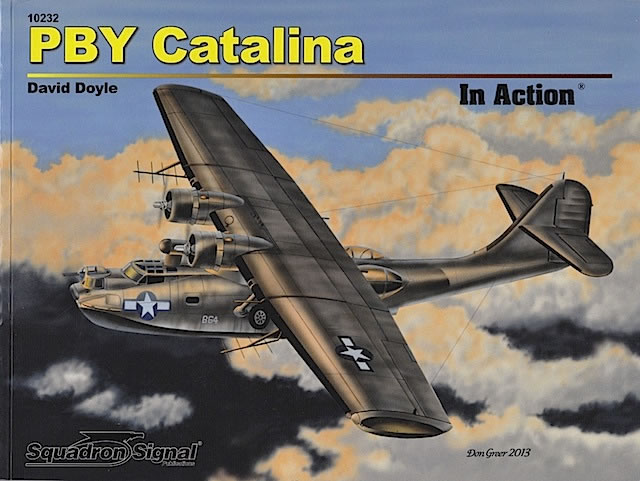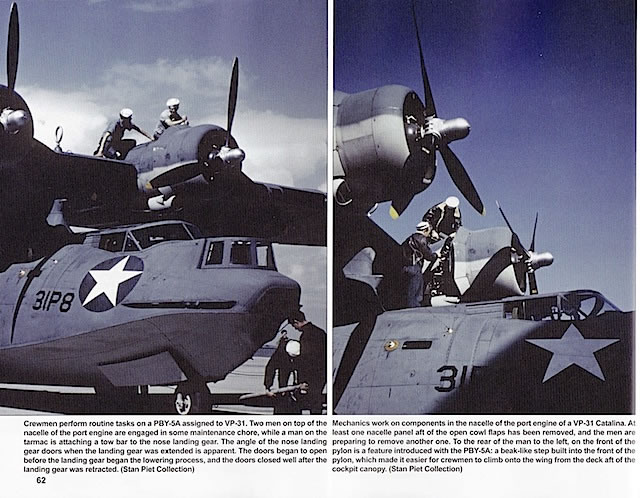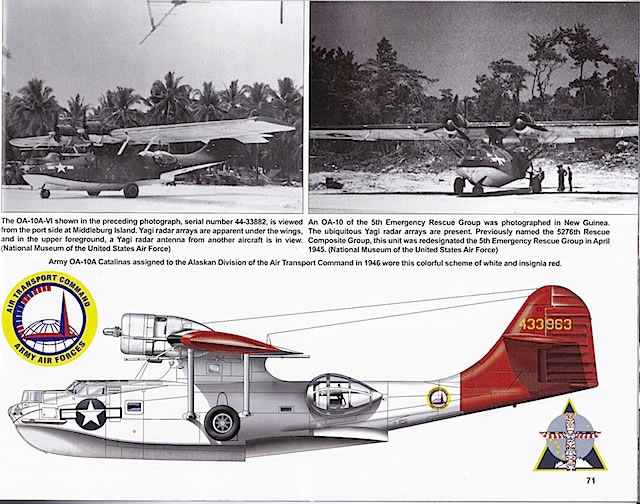PBY Catalina in Action
by David Doyle

Squadron-Signal Publications
| S u m m a r y |
Publisher, Title and ISBN: |
Squadron Signal Publications
PBY Catalina in Action
ISBN: 978-0-89747-740-6 |
Media: |
Soft cover, 80 pages, A4 landscape format; full colour and black-and-white photographs; black and white four view plans and line drawings |
Price |
USD $13.27 available online from Squadron/Signal Publications and from specialist book and hobby shops worldwide. |
Review Type |
First Read |
Advantages |
High quality illustrations and informative text presented in a logical, modeler-friendly format. |
Disadvantages |
|
Conclusion |
A welcome re-pop of an earlier Squadron/Signal publication – the PBY is a fascinating subject, and this book is a great introduction to understanding the type. |
Reviewed by Brad Fallen

PBY Catalina In Action is available online from Squadron.com
The PBY Catalina was first covered in Squadron/Signal’s ‘In Action’ series back in 1983. 30 years later the Catalina again features in this series, with author David Doyle using new research and improved printing technology to take a fresh look at the great flying boat.

I don't have a copy of the 1983 book, so can't say how much original material has been carried over to this edition. What hasn't changed over the years is the ‘In Action’ series’ simple but effective formula: a chronology of airframe development explained through high quality photos and drawings, informative captions and Don Greer's great art.

For the PBY this means the following:
- A short introduction that combines a snapshot of Catalina production between 1935 and 1945 with photos of PBY predecessors such as the XPY-1, XP2Y-1, XP2Y-2, and P2Y-2.
- XPBY-1 – 11 photos of the Catalina prototype, the XP3Y-1/XPBY-1, in its various forms between 1935 and 1936 as Consolidated refined the machine for evaluation by the US Navy.
- PBY-1 – 13 pages are devoted to the first major production variant, and include a number of useful close-up photos of airframe details such as engines, armament and interiors.
- PBY-2 – this five-page section focuses on the PBY-2's modified elevators and horizontal stabiliser, which were the major difference between it and the PBY-1. There is also a small table entitled 'US Navy Production' that lists the gross weight, maximum speed, service ceiling, range, number built, first delivery and serial numbers of each PBY version built – invaluable stuff if you are researching a specific airframe because it saves you from having to search for this information on the internet.
- PBY-3 – “the one noticeable difference of the PBY-3 over the PBY-2….[,] the intake for the downdraft carburetors”, is clearly illustrated by photo and line drawing in this five page section. Also included are some great period colour photos, particularly one of a PBY being dragged ashore by a team of handlers.
- PBY-4 – upgraded engines, the addition of propeller spinners and – in the final four aircraft – the addition of waist blisters were the main improvements to this version of the PBY. The highlight of this five-page section is a colour photo of gunner manning a .30 caliber waist gun, from which many useful details can be drawn.
- PBY-5 – at 684 examples built this was the second most produced Catalina, after the PBY-5A at 802 examples. This ten-page section explores the version’s key features including redesigned cowls and tail surfaces, upgraded engines and standardisation of the waist blisters that were introduced at the end of PBY-4 production. Two PBY-5 colour profiles round off the section.
- PBY-5A – at 22 pages this section is the core of the book, and thoroughly covers the PBY-5A in terms of both airframe detail and operational use. If I were building the 1/48 Monogram kit, particularly, I would have this chapter open on my bench.
- OA-10 – seven pages are devoted to the USAAF’s 410 search and rescue PBYs, and include some colour photos of brightly marked postwar machines.
- PBN-1 – the two pages given to this version (most of which went to the Soviet Union) include clear photographic and diagrammatic coverage of the type’s retractable power bow turret and unique wingtip floats.
- PBY-6A/OA-10B – the book’s last three pages cover this final PBY version.
Production values are high throughout, with no typographic errors noted. The photographs are all reasonable to very good quality, with the black-and-white walkaround and period colour photos a highlight.
The captions are succinct and informative; I especially like how the first caption in each section outlines the key features of the PBY version under consideration. Very thoughtful from a modeler’s perspective!
‘PBY Catalina’ is a welcome re-pop of an earlier Squadron/Signal publication. The PBY is a fascinating subject, whether you’re a modeler or not, and this book is a great introduction to understanding the type.
Thanks to Squadron for the sample.

Review Copyright © 2014 by Brad Fallen
This Page Created on 14 December, 2014
Last updated
14 December, 2014
Back to HyperScale Main Page
Back to Reviews Page
|
